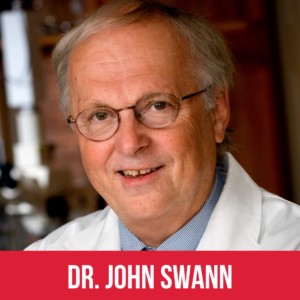Key Points:
- John Swann, PhD, and his team explored an underlying cause of infantile spasms (IS), a devastating epileptic encephalopathy (an epilepsy syndrome that can lead to deterioration of the brain) that typically begins
 within the first year of life. This new research, funded by the National Institutes of Health (NIH), was a direct result of Dr. Swann’s findings from his work as a member of the CURE Epilepsy Infantile Spasms Initiative, conducted from 2013-2017.
within the first year of life. This new research, funded by the National Institutes of Health (NIH), was a direct result of Dr. Swann’s findings from his work as a member of the CURE Epilepsy Infantile Spasms Initiative, conducted from 2013-2017. - Standard treatments for IS work in only approximately 50% of patients and can have severe side effects. The need for additional effective therapies drove Dr. Swann and his team to explore a more effective treatment with fewer or, ideally, no side effects.
- Through extensive experimentation with an established rat model of IS and parallel studies in human tissue removed during epilepsy surgery, Dr. Swann observed very low levels of an important growth factor in the brain which has the potential to be a promising new treatment for this severe form of epilepsy.
Deep Dive:
Infantile spasms (IS) is a rare catastrophic form of epilepsy with approximately 90% of the cases beginning within the first year of life [1,2]. The condition is characterized by seizures with sudden brief jerking movements of the arms and legs or head bobs and often, though not always, an atypical, chaotic pattern of brain waves on the electroencephalogram (EEG) known as hypsarrhythmia [3]. The seizures are accompanied by significant development delays as well as cognitive and physical deterioration [2]. Standard treatments include adrenocorticotropic hormone (ACTH) or prednisone, and the antiseizure medication vigabatrin [4]. Unfortunately, only approximately 50% of children with IS respond to these treatments and there remains no reliable way of predicting who will respond favorably [4]. Even if these treatments diminish IS symptoms for a specific patient, they can have serious side effects. Therefore, scientists have been searching for other drug targets with the ultimate goal of developing alternative therapies.
One of these scientists is Dr. John Swann, Professor of Pediatrics at the Baylor College of Medicine, Director of the Gordon and Mary Cain Pediatric Neurology Research Foundation, and Principal investigator at the Jan and Dan Duncan Neurological Research Institute at Texas Children’s Hospital, who leveraged findings from his work as part of the CURE Epilepsy Infantile Spasms Initiative (2013-2017). With additional funding from NIH, Dr. Swann and his team used a previously developed rat model of IS [5] that mirrors many of this disorder’s symptoms, to investigate spasms that result from pediatric brain injuries, such as those suffered during a traumatic birth.
He and the team wanted to determine if the level of a substance known as insulin-like growth factor-1 (IGF-1) was altered in the injured brains of both their rat model and in IS patients, the latter using brain tissue from IS patients who had undergone neurosurgery to stop their seizures. The rationale behind this experiment was based on two observations. The first is that the level of IGF-1 in the cerebrospinal fluid of IS patients with preexisting brain damage is low [6], and second is that IGF-1 activates a biological pathway crucial for proper brain development and neuronal function [7]. As hypothesized, data revealed that IGF-1 levels were lower in brain tissue from both the rat model and from infants with IS. Data also showed that reduced expression of IGF-1 in the rat model affected the biological pathways critical for neurodevelopmental processes [8].
These promising findings suggested that increasing the amount of IGF-1 in the brains of the rat model might alleviate at least some of the symptoms of IS. To test this idea, the researchers employed a shorter version of IGF-1 called (1-3)IGF-1 which is a natural breakdown product of IGF-1 that can cross the blood-brain barrier with much higher efficiency than the full-length IGF-1 [9].
After confirming that (1-3)IGF-1 could activate the same biological pathways responsible for regulating the processes involved in early brain development as full-length IGF-1, the researchers administered it to their rat model and successfully eliminated both the spasms as well as the hypsarrhythmia in most rodents. This exciting finding suggests that this smaller (1-3)IGF-1 or perhaps an IGF-1-like drug may one day be used to treat IS patients immediately after the condition is diagnosed. This new approach could potentially reduce or even eliminate the associated neurodevelopmental and cognitive effects of this devastating disorder without the side effects of the currently available treatments. Dr. Swann states that this research and subsequent additional funding from NIH to continue the work would not have been possible without his participation in the CURE Epilepsy Infantile Spasms Initiative.
Literature Cited:
- Pellock, JM et al. Infantile spasms: a US consensus report. Epilepsia 2010; 51: 2175-2189
- Cowan, L.D. & Hudson, L.S. The epidemiology and natural history of infantile spasms. Child Neurol. 1991; 6(4): 355-364.
- Gibbs, E.L., Fleming, N.M, & Gibbs, F.A. Diagnosis and prognosis of hypsarrhythmia and infantile spasms. Pediatrics 1954; 13(1): 66-73.
- Knupp, K.G. et al. Response to treatment in a prospective national infantile spasms cohort. Neurol. 2016; 79(3): 475-484.
- Lee, C.L. et al. A new animal model of infantile spasms with unprovoked persistent seizures. Epilepsia 2008; 49(2): 298-307.
- Riikonen, R.S. et al. Insulin-like growth factor-1 is associated with cognitive outcome in infantile spasms. Epilepsia 2010; 51(7): 1283-1289.
- O’Kusky, J. & Ye, P. Neurodevelopmental effects of insulin-like growth factor signaling. Neuroendrocrincrinol. 2012; 33(3): 230-251.
- Ballester-Rosado, C.J. et al. A role for insulin-like growth factor 1 in the generation of epileptic spasms in a murine model. Neurol. 2022; 92(1): 45-60.
- Yamamoto, H. & Murphy, L.J. Enzymatic conversion of IGF-1 to des(1-3)IGF-1 in rat serum and tissues: a further potential site of growth hormone regulation of IGF-1 action. Endocrinol. 1995; 146(1): 141-148.

